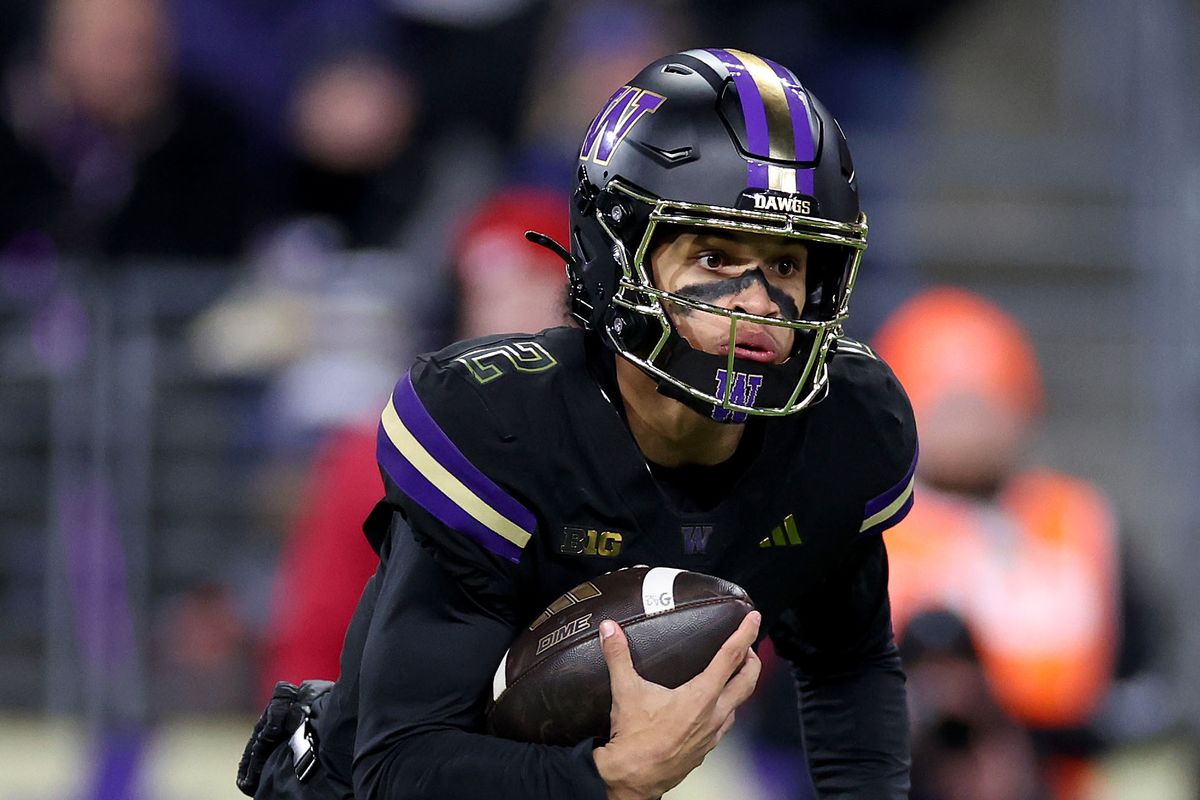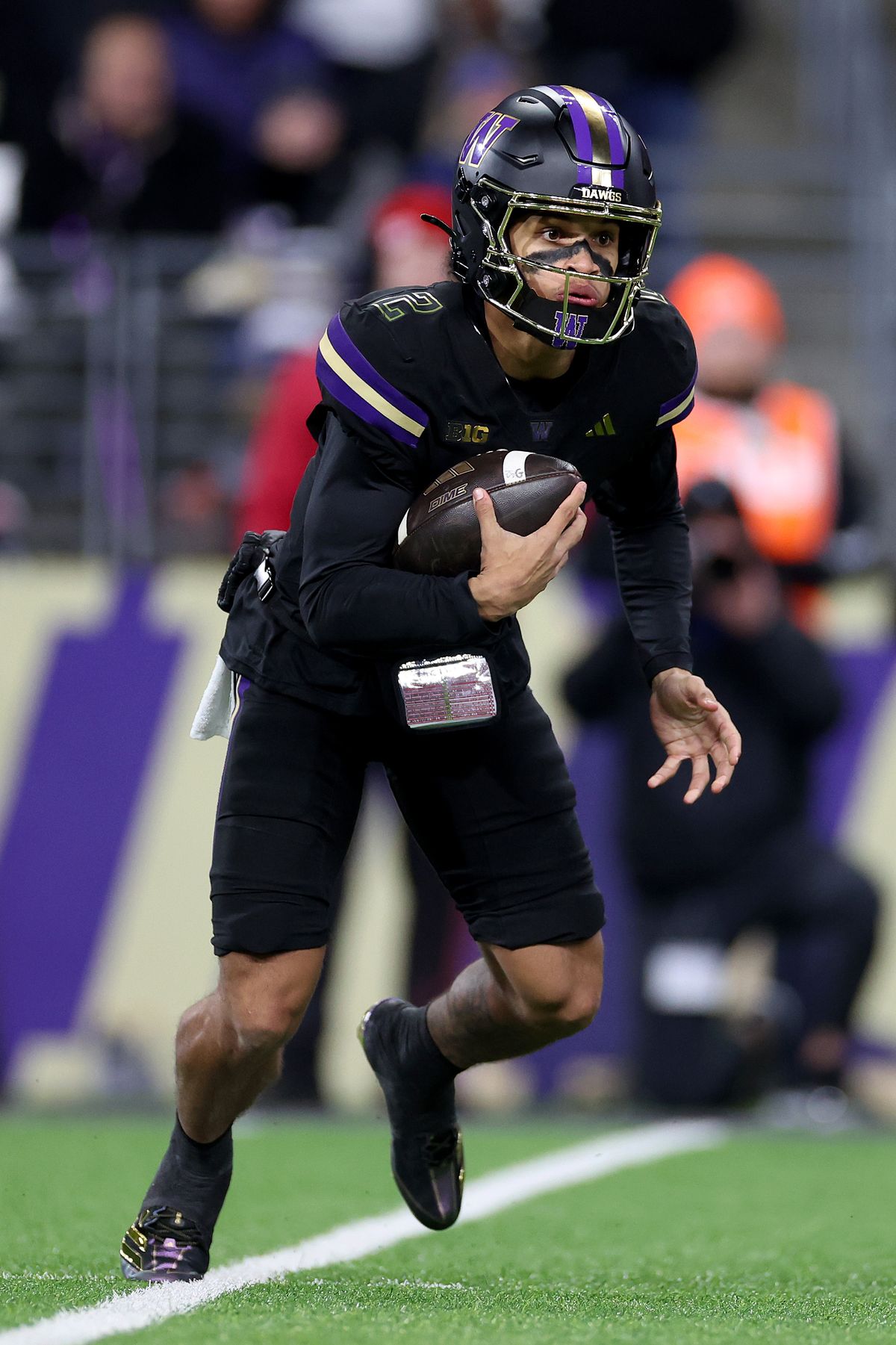Commentary: Why QB Demond Williams Jr.’s emergence significantly alters Huskies’ ceiling
Demond Williams Jr. completed 7 of 8 passes for 67 yards and a touchdown in a 31-19 win over UCLA on Nov. 15. (Getty Images)
SEATTLE – On an overcast April day inside Husky Stadium, Demond Williams Jr. was asked if he was pushing to start as a true freshman. It was a foregone conclusion, of course, that fifth-year senior Will Rogers – who brought 12,315 career passing yards and 94 touchdowns from Mississippi State to Seattle last offseason – would eventually earn the role.
But Williams paused, smiled and shrugged, perhaps concocting a politically correct answer.
“That’s the goal,” he finally said. “That should always be the goal.”
Williams – a 5-foot-11, 187-pound quarterback – improbably achieved that goal, wresting the job from Rogers with a late-season surge. The former four-star recruit expertly relieved Rogers in a 31-19 win over UCLA on Nov. 15, completing 7 of 8 passes for 67 yards and a touchdown (plus 31 rushing yards).
The day prior, I wrote that Rogers should remain in the starting role. I underestimated what Williams could do.
Jedd Fisch did not.
In two starts since, Williams both justified Fisch’s QB switch and provided a tantalizing tease for 2025. In a 49-21 loss at No. 1 Oregon on Nov. 30, the Chandler, Arizona, product completed 17 of 20 passes (85%), throwing for 201 yards and a touchdown. Despite the circumstances – namely, a first career start on the road against your primary rival and the top team in the land – Williams was an encouraging outlier, imperfect yet impressive.
Then, in Tuesday’s 35-34 Sun Bowl loss to Louisville, Williams was even better – finishing with 81.3% completions, 374 passing yards, four passing touchdowns, one interception, 48 rushing yards and a 7-yard rushing score. The diminutive dual-threat QB connected with Giles Jackson for 40-, 49- and 31-yard touchdowns, before finding Jackson again for a 1-yard back-shoulder looper with nine seconds left.
His most impressive play came earlier on the same drive – when Williams took a shotgun snap, stepped up, spun out of pressure and released a sack-evading wobbler that wide receiver Jeremiah Hunter centered under for an improbable 33-yard gain.
“Literally, I think he has a chance to win the Heisman (someday),” Jackson said after the game.
Granted, Williams is a long way – literally and metaphorically – from New York City. He took 10 sacks against Oregon, occasionally extending plays to UW’s detriment. He also threw an interception return for touchdown on UW’s opening drive on Tuesday, before failing to find Hunter for a 2-point try that would have effectively won the game.
Still, in two starts against teams with a combined record of 22-5, Williams completed 43 of 52 passes (82.7%) and threw for 575 yards with six touchdowns, one interception and 65 rushing yards. These weren’t padded stats against inferior opponents. They weren’t screen passes preceding 60-yard sprints, or mirages masquerading as meaningful strides.
Fisch acknowledged after the Louisville loss that Williams is “going to have to learn and grow, and we’re going to have some growing pains during that process.”
That’s all well and good. It’s important not to place premature pressure or expectations on an 18-year-old freshman with two total starts and 105 pass attempts.
But this is a process UW fans will want to witness nonetheless.
Flatly, Williams’ emergence significantly alters the Huskies’ ceiling, as is the case with any standout quarterback. The proof is in this program’s past. In 2022, Michael Penix Jr. inherited a 4-8 roster and proceeded to go 25-3 in two spectacular seasons. And while plenty of people deserve credit – head coach Kalen DeBoer, offensive coordinator Ryan Grubb, the team’s nine other draft picks in 2024 – can you imagine the same success without a Heisman contender under center?
Now, no one is calling Williams the second coming of Penix, a generational player with an incomparable skill set.
But a prolific player, at that position, can lift a program.
It’s Fisch’s job to help his soon-to-be sophomore maximize his impact.
“The idea here would be to continue to let him grow and develop, and then we have 252 days between the last game and the Colorado State game (UW’s 2025 season opener on Aug. 30),” Fisch said on Dec. 17. “What we do in those 252 days will all be based on how we play and what it looks like and giving Demond every opportunity to showcase all of his skills. Then it’s our responsibility as an offensive staff, now that we see that, to determine what he can do best.”
It’s also their responsibility to surround the quarterback with a capable supporting cast, an ongoing process in the transfer portal. UW’s lacking offensive line – which surrendered three sacks per game, 117th in the nation – has added a pair of likely starters in Kansas State tackle Carver Willis and Oklahoma guard (and former Husky) Geirean Hatchett. Texas wide receiver Johntay Cook II announced a transfer to Washington last week, as well.
On paper, the Big Ten’s present bullies – Ohio State, Penn State, Oregon – have the recruiting resumes and NIL resources to continue to dominate the conference and contend for national titles.
But the Huskies have a quarterback.
Which, after a 6-7 season, allows 252 days to dream up some grander goals.
“We still haven’t even been here a year. To be around these kids and these guys has just been so special,” Fisch said Tuesday. “They certainly have laid the foundation of a team that’s going to fight, a team that’s going to play extremely hard, a team that has an elite freshman playing quarterback, and a team that’s going to be out here battling every year to be in the playoff games.”

